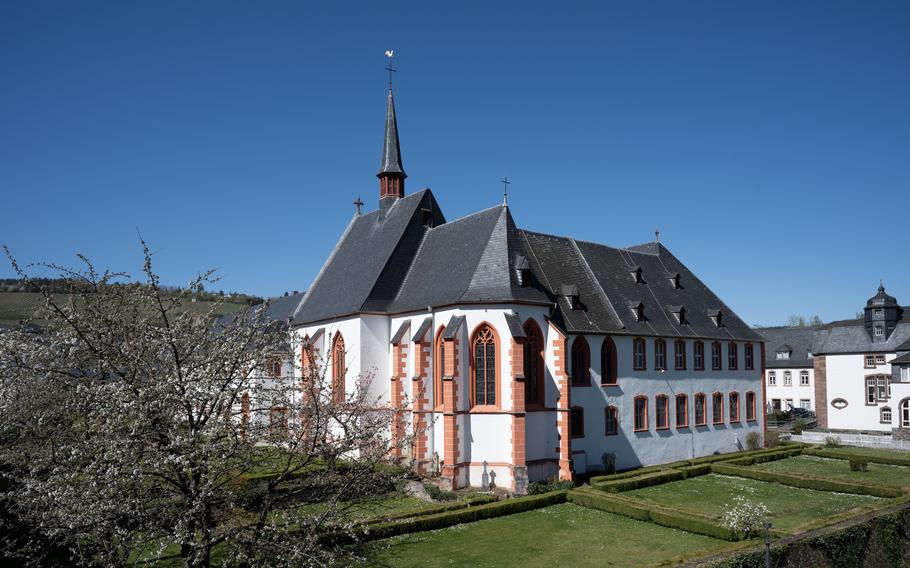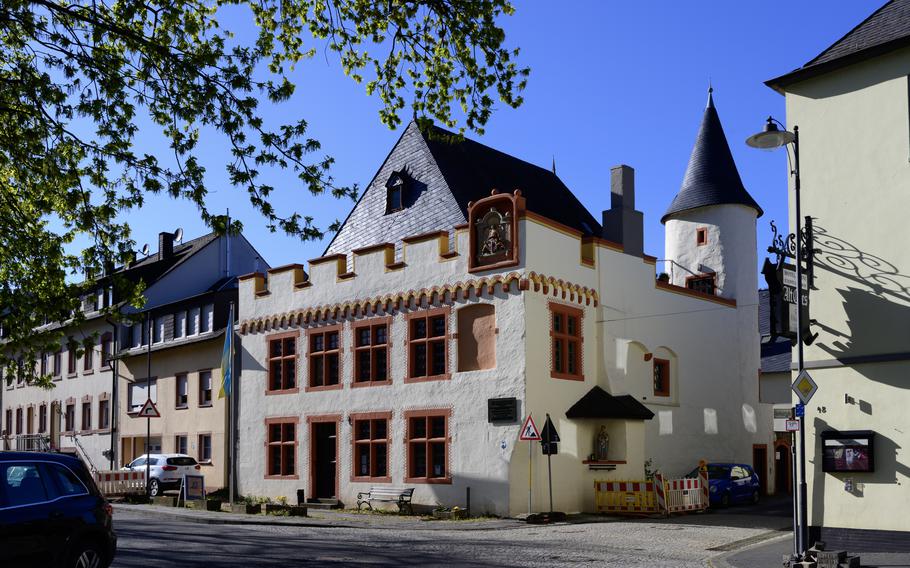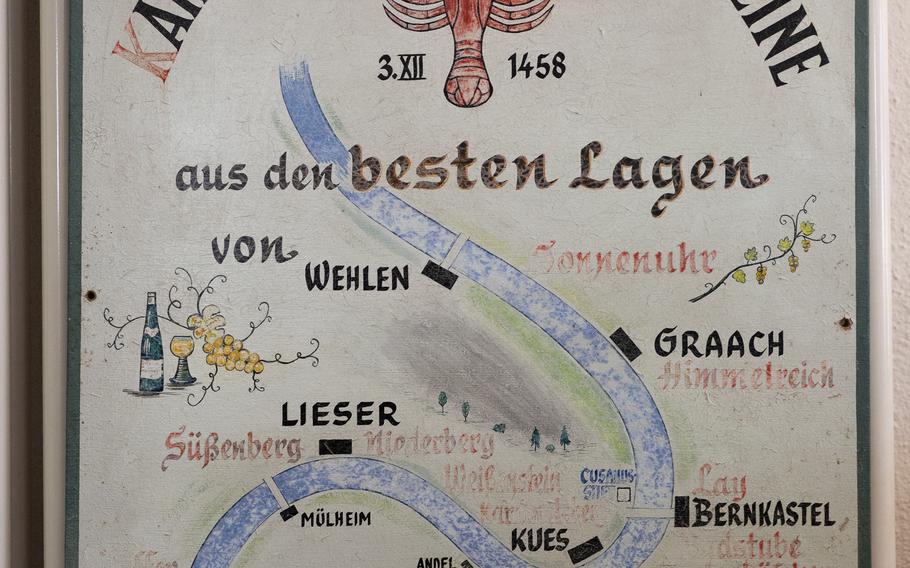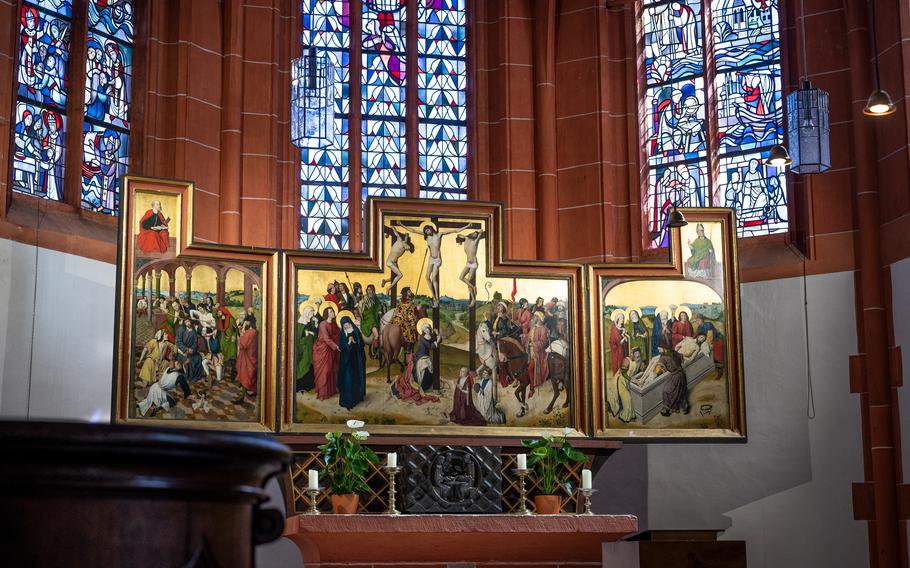
The St. Nikolaus Hospital/Cusanus Foundation building forms the heart of a multipurpose complex along the Moselle River in Bernkastel-Kues, Germany. Built by a Catholic cardinal and medieval polymath named Nicholas of Cusa in 1458, it serves as a retirement home, a wine business and a repository for the cardinal's library. (David Edwards/Stars and Stripes)
Imagine having among your circle of acquaintances an astronomer, a mathematician, a philosopher, a legal scholar, a political theorist, a diplomat, a mystic, even a game inventor.
Now imagine that they’re all the same person.
The Moselle River city of Bernkastel-Kues, Germany, can relate. Roughly an hour and 10 minutes from Ramstein Air Base by car, it’s a veritable monument to a 15th-century native son named Nicholas of Cusa, a cardinal who embodied the term “Renaissance man.”
Two years ago, I made my first visit. On the bridge joining the two parts of town I saw the Cusanus sundial and wondered, “Who or what is Cusanus?”
That was Nicholas’ Latin moniker. Thus began my recent quest to learn more by visiting the two main sites dedicated to him.
The Cusanus Geburtshaus is a museum in the house where he was born. It’s about a mile’s walk from the Cusanusstift, a riverside complex that unites a highly unusual combination of functions ranging from library to winery to retirement home.

The house in Bernkastel-Kues, Germany, where Cardinal Nicholas of Cusa was born in 1401 is now a museum known as the Cusanus Geburtshaus. Nicholas came from a wealthy merchant family and went on to become one of the intellectual giants of the Renaissance. His will directed his assets to the establishment of a retirement home, which has been in continuous operation since 1458. (David Edwards/Stars and Stripes)
Cusanusstift (Cusanus Foundation)
Besides the sundial, the town renders homage to Nicholas with innumerable portrayals of the family crest or its dominant feature, a crawfish, as his surname Krebs is synonymous with the German word for the crustacean.
Also referred to as St. Nikolaus Hospital, this white building with red trim and crawfish depictions galore occupies prominent real estate next to the Kues end of the bridge.
The wine shop here sells bottles of its own label as well as those of other Moselle vintners. Most attractions in the main building can be seen on a self-guided tour, aided by a brochure available in English.

Land holdings that include 22 acres of vineyards in prime locations on the Moselle River have formed the economic underpinnings of the St. Nikolaus Hospital rest home in Bernkastel-Kues, Germany, since its founding in 1458. The St. Nikolaus Hospital winery cultivates mostly riesling vines and is one of the oldest foundation wineries in Europe. (David Edwards/Stars and Stripes)
But in April, I brought along a German companion for a biweekly guided tour, because that’s the only way to see the library.
By agreement with her and the other native German speaker who joined us, our guide, Genevieve Schwartz, conducted the tour mostly in English. I later found out that English-language tours can be arranged in advance.
After recounting the story of how Nicholas founded the hospital in 1458 as a rest home for 33 aged residents, she pointed out a couple of the building’s architectural distinctions.
Each of the four passages in the cloisters’ interior has a different form of vaulting, while all of the courtyard’s 22 windows, which I admit didn’t seem to stand out at first, have individualized tracery that isn’t duplicated in any of the others.
The building exemplifies the “unity in diversity” tenet of Cusanus’ philosophy, Schwartz explained.

The altarpiece in the chapel of the Cusanusstift building is a triptych, with the central panel portraying the Crucifixion. Cardinal Nicholas of Cusa and his brother Johannes are shown kneeling at the foot of the cross. A small window in the library overlooks the chapel. (David Edwards/Stars and Stripes)
In the chapel, she elaborated on the triptych altarpiece, with its Crucifixion scene in the center panel portraying Nicholas and his brother Johannes kneeling beside Jesus.
We also saw the memorial slab, beneath which the cardinal’s heart is buried in a leaden box.
The tour concluded in the library, a small room that highly impressed me. Its roughly 300 volumes date from the ninth to 15th centuries and include a Quran and a medical treatise by the ancient Greek physician Galen.
We also saw scientific instruments that Cusanus used and schoolwork he did at the University of Padua. Schwartz told us that he had devised a model of the universe centered on the sun about 100 years before Copernicus.
Cusanus Geburtshaus
The exhibits in this diminutive house museum are German-only. But even with my limited understanding, I appreciated what it offers.
First among the highlights for me was the detailed map of Nicholas’ journey to Constantinople in 1437 as part of a papal delegation to the Byzantine patriarch in hopes of reunifying Christendom. For centuries, it had been split by a schism between the Roman Catholic Church and the Eastern Orthodox churches.
The map complemented a stained glass window pane in the Cusanusstift chapel showing Nicholas flanked by Hagia Sophia, the world-famous church-turned-mosque in Istanbul that once epitomized the Orthodox faith.
I also gravitated to a display of the title page from a medieval edition of Nicholas’ “The Catholic Concordance.” In this seminal work of political thought, he preceded the American Founding Fathers by three centuries in arguing that government legitimacy requires the consent of the governed.
The images of a broad range of illuminated manuscripts, combined with a walk to the museum that takes visitors either along the riverside pedestrian path or past the front faces of exquisite mansions, also made the visit here worthwhile.
Bernkastel-Kues has become one of my favorite places in Germany, and even people who don’t feel the same pull of a medieval super-brainiac will likely find something alluring there.
Cusanus sites
Address: St. Nikloaus Hospital/Cusanusstift, Cusanusstrasse 2, Bernkastel-Kues, Germany; Cusanus Geburtshaus, Nikolausufer 49/50, Bernkastel-Kues, Germany
Hours: For the Cusanusstift main building, Sunday through Friday, 9 a.m.-6 p.m.; Saturday, 9 a.m.-3 p.m. Guided tours offered Tuesday at 10:30 a.m. and Friday at 3 p.m. For the birthplace house museum, Tuesday through Sunday, noon-5 p.m.; closed Monday.
Prices: Self-guided tours of the Cusanusstift are free; guided tours cost 10 euros per person, cash only. Admission to the Geburtshaus is 4 euros for adults and 2 euros for teens, students and people with a disability.
Information: www.cusanus.de, https://ring-mosel.de/weingueter/weingut-stiftung-st-nikolaus-hospital, www.nikolaus-von-kues.de/geburtshaus/das-museum/